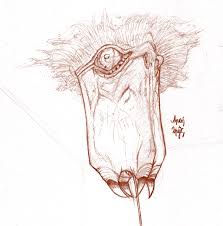- Joined
- Jun 23, 2023
- Messages
- 50
- Thread Author
- #1
Project Xenobarnicia
Introduction
Dear reader,
Wha is Project Xenobarnicia

Project Synopsys/Overview
Project Benefits
Required Resources
The following resources listed are essential for the success of the project:
Personnel Information

Introduction
Dear reader,
The following document serves the purpose of archiving the project proposal and further updates concerning this project. For ease of access, it has been uploaded into the Facility's Intranet. For a physical copy, please contact the leader of this project Dr. Winslou Carter or any responsible Head Scientist, Director of Science included.
Wha is Project Xenobarnicia
Xenobarnicia is an extraterrestrial organism, known simply as "Barnacle", that resides on ceilings and remains stationary. One of its remarkable features is its distinct approach to capturing prey through the utilization of a sticky "tongue."
Project Synopsys/Overview
This scientific project aims to investigate the anatomy, behavior, and functional adaptations of the Barnacle's tongue. Through a multidisciplinary approach encompassing anatomical studies, behavioral observations, biochemical analyses, and genetic investigations, this project seeks to unravel the mechanisms underlying the Xenobarnicia's tongue functionality. The project's goals include understanding the tongue's structure, examining feeding behavior, conducting comparative studies, analyzing biochemical and genetic aspects, exploring potential regenerative capabilities, and assessing the ecological significance of the Barnacle's feeding behavior. Overall, this project aims to advance our understanding of this intriguing organism and contribute to various fields of study, including biology, biomimetics, evolutionary biology, regenerative medicine, and ecology.
Project Benefits
By unraveling the mechanisms underlying the tongue's functionality, this project will advance our scientific knowledge, shedding light on the unique adaptations and evolutionary significance of this organism. The findings can inspire biomimetic applications, potentially leading to the development of innovative technologies or materials. Understanding regenerative capabilities, if present, could have implications for regenerative medicine and tissue engineering. Comparative studies will contribute to our understanding of evolutionary biology, while assessing the ecological significance of the Barnacle's feeding behavior can aid conservation efforts and ecosystem management. Ultimately, this project has the potential to make valuable contributions across multiple fields, ranging from biology and technology to medicine and ecology.
Required Resources
The following resources listed are essential for the success of the project:
- A sufficient number of Xenobarnicia specimens will be needed for anatomical dissections, behavioral observations, and biochemical analyses; (can be obtained through fieldwork or specialized sources)
- Equipped laboratories with appropriate workstations, microscopes, dissection tools, and imaging systems will be essential for conducting anatomical examinations, biochemical analyses, and genetic studies;
- Access to molecular biology equipment and techniques will be required for genetic analyses, such as DNA extraction, PCR amplification, gene sequencing, and gene expression studies;
- Various biochemical analysis tools including spectrophotometers, gel electrophoresis systems, chromatography equipment, and enzyme assay kits, will be necessary to analyze the biochemical composition and properties of the Xenobarnicia's tongue;
- Computer systems equipped with data analysis software such as statistical analysis programs and bioinformatics tools, will be needed to process and analyze the collected data, including genetic sequences, biochemical data, and behavioral observations;
- Access to scientific journals, books, and online databases will be essential for reviewing relevant literature, understanding the current state of knowledge, and contextualizing the findings within existing research;
- A team of qualified research assistants and technicians with expertise in various fields such as anatomy, molecular biology, biochemistry, and data analysis, will be valuable in conducting the experiments, managing the laboratory work, and assisting with data analysis;
- Adherence to ethical guidelines and obtaining necessary permits or approvals for working with animals (if applicable) will be crucial to ensure responsible and ethical conduct throughout the project;
- Adequate funding will be required to support the project's operational costs, including procurement of equipment and supplies, travel expenses (if applicable), and personnel salaries.
Personnel Information

Title | Forename | Surname |
|---|---|---|
Doctor | Winslou | Carter |
Current position and occupation |
|---|
Laboratory Director of Vivarium |
Field of Specialisation |
|---|
| Botany, Biochemistry, Data Analysis |
Last edited:



